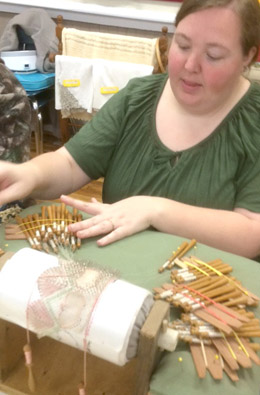Bobbin lace session planned Saturday during Gathering on Appalachian Life
PICKENS — Patti Gonzalez invites those who enjoy creating bobbin lace, and everyone who wishes to learn more about it, to join her and other bobbin lacers in the Granger Fiber Arts room at the Senior Center of Pickens beginning with the bobbin lace two-hour session at the Gathering on Appalachian Life this Saturday, Feb. 27.
Gonzalez’s male and female students range in age from 14 to senior adults.

Patti Gonzalez makes Pickens-Pu’kintown Lace. Gonzalez will lead a two-hour bobbin lace session during the Gathering on Appalachian Life this Saturday in Pickens.
Gonzales has been fortunate to study bobbin lace with Robin Lewis-Wild in Lewis-Wild’s home in Mineral Bluff, Ga. Lewis-Wild is an internationally recognized lacer known for publishing book using color coded diagrams for instruction which reduces confusion among bobbin lace terms and techniques used by different lacing communities in America and abroad. Lewis-Wild teaches bobbin lace at the John C. Campbell Folk School in Brasstown, N.C. She has offered the Senior Center of Pickens Inc. her framed collection of nearly 100 handmade bobbin lace pieces from the book, four antique pillows with lace attached and her bobbin lace library of 250-300 titles. Her library includes lace patterns, rare and out-of-print bobbin lace books, and current texts. The public will be invited to visit her library and collection of fine lace and antique pillows once they have been prepared for display.
Lewis-Wild was commissioned by the Tennessee Valley Authority to produce a multi-story, three-panel bobbin lace hanging which hung in the atrium of the authority’s office building in Chattanooga. Pictures of this three-piece hanging, the crane hoisting one of the panels and Lewis-Wild working on a specially built table necessary for her to create the hangings are also included with her collection.
In the 1980s, Lewis-Wild came to Pickens to meet with Betty Dalton and teach a small group of ladies to make bobbin lace. In the 1990s, Dalton introduced Lucy Harward and her friends to Lewis-Wild. Since then, Harward has studied bobbin lace with Lewis-Wild at John C. Campbell Folk School and in Lewis-Wild’s home on occasion.
During 2015, Lewis-Wild designed an original lace pattern for Lucy and Dale Harward. The Harwards requested that the motifs in the lace include pumpkins. This lace was specifically designed for the Pickens-Pumpkintown area and has been named Pickens-Pu’kintown Lace. The Harwards own the master patterns for this lace. The patterns will be shared with bobbin lace students and accomplished lacers at the Senior Center of Pickens. Both Gonzalez and Harward have made pieces of the Pickens-Pu’kintown Lace which are on display in the Granger Fiber room along with other lace made by them and Gonzalez’s students.
Even today, many Americans do not know what bobbin lace is. It is handmade lace made with threads which are first wound onto bobbins and then braided, crossed and twisted in a variety of techniques to create intricate lace patterns. The threads are woven over patterns called prickings and held in place on firm pillows by straight pins until a section or motif of the design is complete. Once the pins are removed, the lace retains its shape and design.
Traditionally bobbin lace was made with precious metals, linen, silk or wool threads. Later it was made with cotton threads. It was largely made by the poor, but used for the decoration of clothing for the rich and famous. Even though most lace worn in the colonies was ordered from London in the late 18th century, it is documented that up to 41,000 yards of black laces and white edgings were produced in one year by more than 600 workers in Ipswich, Mass. Bobbin lace-making flourished as a cottage industry along the northeastern coast until the advent of the net machines in the early Nineteenth Century when lacers turned to the more lucrative business of embroidered net. Bobbin lace groups continue to make lace for pleasure in the Appalachian region and throughout the country. There are bobbin lacers in Hendersonville, Asheville, Atlanta, Greenville, Columbia and Charleston to mention a few areas nearby.
Handmade lace can take an hour or more per square inch to make, so placing a monetary value on it is difficult to do. Little is made and even less is sold. In 2009, Lorelei Halley said lace-makers should market their handmade lace as wearable art the same as modern high-priced dress designers market their $20,000.00 dresses. An internet search on Feb. 8 listed two bobbin lace patterns for sale. Baby lace, about one half inch in width, was available for $16.45 for six inches. A shell design about 1 inch wide was available for $69.95 for six inches. The Granger Fiber room teaches participants to make their own bobbin lace, both for the pleasure of making lace for one’s family and friends and also to make it more affordable for those who appreciate it.
There are some locations for fine collections of old bobbin lace in the United States. These include the Cooper Union Museum, the Metropolitan Museum of Art in New York, the Gardiner Museum in Boston, and the Art Institute in Chicago. The current Southeast director of the International Organization of Lace is familiar with Lewis-Wild’s work. She does not question that the Robin Lewis-Wild Bobbin Lace Library and Collection to be housed in the Senior Center of Pickens is the most valuable and complete in the area. She is helping Harward verify this by sending out a survey asking for known bobbin lace libraries and collections among the guilds in the Southeast.
Gonzalez will lead the two-hour bobbin lace session at the Gathering on Appalachian Life on Saturday. The bobbin lace sessions will be held in the Granger Fiber Arts room at the Senior Center of Pickens. Participants will need to pre-register for the two-hour session. Registration may be online or by stopping by the Granger Fiber Room at the Senior Center or the Pickens Chamber of Commerce at 222 W. Main St. to pick up a registration form. The bobbin lace session will be held from 2:15-4:30 p.m. in the Granger Fiber Room. It is very important to pre-register for the two hours of instruction to make sure that an adequate number of supplies is provided. Pillows, patterns, pins, wound bobbins and instructions will be provided at no cost above the registration fee. These supplies and the Torchon background the participants create during the session will become the property of the participants. Participants will be welcomed to join the Granger Fiber Arts Lacers and attend regularly scheduled bobbin lace sessions in the future in the Granger room at the Senior Center at 129 Schoolhouse St. in Pickens.
Contact Harward at (864) 419-1794 or daleandlucy@gmail.com with questions.



























